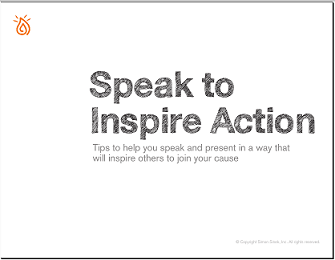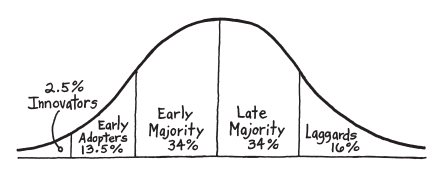Simon Sink How to speak in such a way as to induce action (part 1)
- Transfer
 Back in March, I published an article based on a performance by Simon Sinek at TEDx. In my opinion, it turned out to be somewhat underestimated, I did not receive a single comment, although the material is quite interesting.
Back in March, I published an article based on a performance by Simon Sinek at TEDx. In my opinion, it turned out to be somewhat underestimated, I did not receive a single comment, although the material is quite interesting. In the process of preparing that article, I registered on Simon’s website and received a brochure, the translation of which I want to submit today. So, Speak to Inspire Action - tips to help you talk and point out a path that will inspire others to join your cause.
In order for our world to change for the better, great ideas must somehow spread. In order for the idea to spread, it must be sufficiently clear. When ideas are easy to understand, they become more effective. We wake up every day to inspire people and do things that inspire them. The tips and ideas presented in this essay are written by Simon Cink and are intended to help the reader speak and present their ideas in such a way as to inspire other people's interest in these very ideas. Co-creation is much better than working alone.
1. Speak to those who are interested
A clearly defined goal quickly attracts supporters and repels skeptics. It is immediately necessary to speak with those whose attention has already been attracted, and not to convince or “sell” the idea with a skepticism.
When we try to convince others of our innocence, we occupy a position in which part of the audience can make opposition judgments. The best way to get the necessary dynamics (traction) of your ideas is to focus your time and attention on those who already believe in them and voluntarily expand the number of followers and like-minded people.
 In his speeches and publications, Simon often refers to the law of the spread of innovations (diffusion of innovations) and, illustrating this law, a bell-shaped graph (normal distribution). Innovators and enthusiasts are those categories of users that primarily require attraction and on which, at first, it is necessary to concentrate all your forces. It is they who strive to be part of something that seems important to them and of what they believe in.
In his speeches and publications, Simon often refers to the law of the spread of innovations (diffusion of innovations) and, illustrating this law, a bell-shaped graph (normal distribution). Innovators and enthusiasts are those categories of users that primarily require attraction and on which, at first, it is necessary to concentrate all your forces. It is they who strive to be part of something that seems important to them and of what they believe in. Most are skeptical, and not ready to accept new ideas not tested by anyone. Focus on the left side of the distribution chart. Yes, we need a majority if we want to change the world, but innovators and enthusiasts inspire it.
Instead of trying to address a large crowd and doubting skeptics, speak where you were invited to speak, where people are open to your ideas and want you to share them. If you bang your head against the wall, you can burn out and your ideas will be lost. Start with those who believe you, believe that they can stand shoulder to shoulder with you.
2. Speak for the audience
When you are making a presentation or giving a presentation, what are your prospects? What is your relationship with the audience? When we speak with a motive different from providing the audience with useful information, the audience will definitely feel it.
On the other hand, agreeing to speak only for money, or in the hope of acquiring useful contacts that may come in handy in the future, or in order to impress management in the hope of career advancement, cannot effectively inspire others. Which does not mean at all that the fee, connections, promotions and other incentives do not matter. Absolutely have. However, these are just side effects.
3. Start with the ultimate goal
This refers directly to the proposed concept “Start With Why”. Before you start moving along the road, you need to know your destination. How would you like people to feel when leaving your presentation? What would you like to achieve by inspiration of your ideas? What is the main idea? When you start with your ultimate goal, you can adapt each story and thought you tell to your destination. It can sometimes be useful to plan a presentation from the opposite. Instead of the first paragraph, start with the final conclusions, then find out what needs to be done in order to arrive at the introductory words, while the main idea should briefly express the whole point of the presentation.
When introducing new material, some speakers, including Simon, move around the stage with the same basic idea. They will tell stories and share experiences related only to this idea and reinforcing only it and nothing more. This ability comes with experience and practice. At the same time, even if you already have a prepared speech, you can still review it in the same way.
4. Take over the hall
 While you are on stage, the whole hall belongs only to you. Being in front of an audience ready to listen to you, when you are ready to convey your idea, the audience feels satisfaction, because you have already laid the foundation for the inspiration of your ideas.
While you are on stage, the whole hall belongs only to you. Being in front of an audience ready to listen to you, when you are ready to convey your idea, the audience feels satisfaction, because you have already laid the foundation for the inspiration of your ideas.Here are some ideas for capturing an audience:
Confidently rise to the stage
Before you begin your speech, you have a way to the stage and the attention of the audience will already be focused on your person before you even begin to speak. If you seem nervous or worried, extraneous conversations in the audience will begin before the first word comes off your lips. A great way to increase the level of comfortable interaction with the audience is to enter the stage. Even if you are in the gallery of the big hall, slowly walk forward. Do not run, do not download, just walk confidently. This approach will help tune into the maximum level of eloquence and persuasive ability.
Pause before you speak
Most of the speakers begin to say as soon as they rise to the stage, this, of course, is not true. One of the best ways to attract attention is to pause before starting a report. Make eye contact with several people in the audience. At first, you may feel a little uncomfortable, but it is a very effective way to communicate with people. Eye contact can provide a much more powerful start than originally planned.
Don't stand still
The way you move on stage will enhance your oral exposure. Great speakers always move on stage quite naturally. Their gestures are fluid and fluid. Simon Sink specially for this took lessons in a ballet class. Ballet gives an idea of the correct movement, while there is absolutely no need to learn pirouettes and other dance movements. Just learn the basics of movement.
5. Talk only about what you know and what concerns you.

Have you ever noticed how passionately parents talk about their children? This only indicates parental care, and not their oratory talent. When you talk about what you love and what you are passionate about, the audience feels it. More naturally, with more passion and energy, you can influence your audience more effectively.
Stick to topics that you understand. We cannot be experts in everything, and too often we try to appear as such. In fact, admitting facts that are unknown to you helps people to trust more when you say that you really know.
When you try to seem like an expert in what you don’t understand, everything said can be perceived as unreliable, as a result of which the whole performance will suffer.
